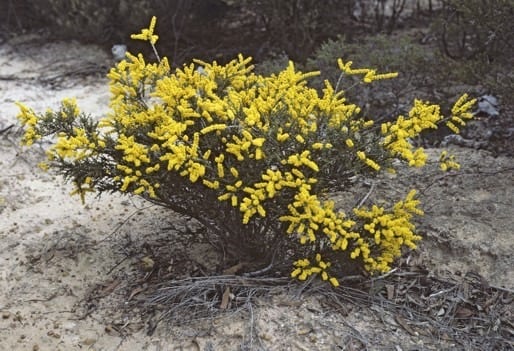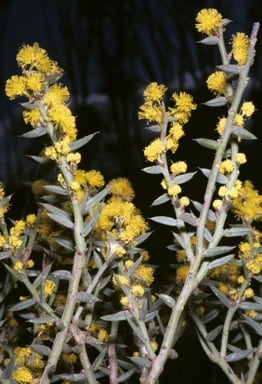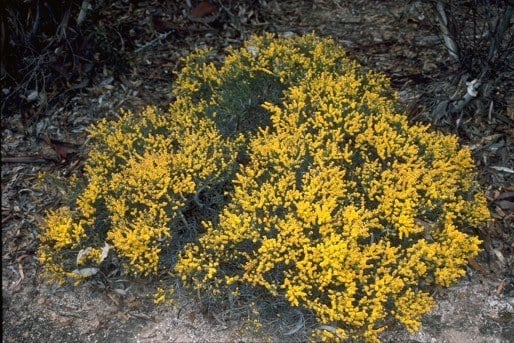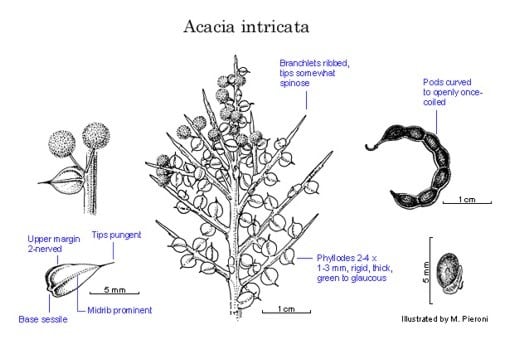Acacia intricata S.Moore
WATTLE
Acacias of Australia
Family
Fabaceae
Distribution
Occurs from Bencubbin and Jaurdi Stn S to Lake Grace and Lake King, south-western W.A.
Description
Compact intricate glabrous shrub 0.15– 0.5 (-1) m high, sometimes forming prostrate mounds. Ultimate branchlets ascending to erect, short, straight, rigid, somewhat spinose, yellow-ribbed, interstices green, sometimes pruinose. Stipules caducous. Phyllodes sessile, ±patent, usually ovate to widely ovate, usually 2–4 mm long, 1–3 mm wide, pungent, rigid, thick, green to glaucous, prominently 1-nerved per face; adaxial margin thickened and 2‑nerved, with adaxial marginal nerves sometimes coalescing. Inflorescences rudimentary binate racemes with axes < 0.5 mm long; peduncles 1.5–4 mm long, recurved in fruit; basal bract caducous, cucullate; heads showy, globular, 7–13-flowered, bright golden; bracteoles absent or resembling sepals. Calyx absent or reduced to a single linear sepal; petals 5. Pods curved to openly once-coiled, to 25 mm long, usually 2-2.5 mm wide. Seeds longitudinal, 2.7–2.9 mm long, commonly mottled; aril 1/2 or more length of seed, white.
Habitat
Occurs in loam, clay and gravelly sand, in woodland and mallee shrubland.
Specimens
W.A.: 19 km due S of Southern Cross, B.R.Maslin 6014 (K, PERTH); 5 km E of Tarin Rock, K.Newbey 2826 (BM, CANB, K, MEL, NSW, PERTH); 11 km SSE of Jaurdi HS, c. 63 km E of Koolyanobbing, K.Newbey 8857 (PERTH).
Notes
There is considerable variation within this species in the Southern Cross-Koolyanobbing area. At one extreme are plants that grow to 1.5–2.5 m tall, have oblong to narrowly oblong or sometimes linear phyllodes 5– 12 (– 20) mm long and pods 3–4 mm wide; these plants may superficially resemble A. acutata or A. haematites. The appears to be a complex array of variation connecting these long-phyllode individuals with plants of typical A. intricata and further study is needed to assess their taxonomic status.
Related to A. coatesii. Acacia erinacea has similarly small phyllodes, spinose branchlets and is sometimes prostrate, but it has innocuous phyllodes which lack a thickened adaxial margin, longer peduncles and straight pods with oblique seeds.
FOA Reference
Data derived from Flora of Australia Volumes 11A (2001), 11B (2001) and 12 (1998), products of ABRS, ©Commonwealth of Australia
Author
B.R.Maslin
Minor edits by J.Rogers
This identification key and fact sheets are available as a mobile application:
URL: https://apps.lucidcentral.org/wattle/
© Copyright 2018. All rights reserved.












